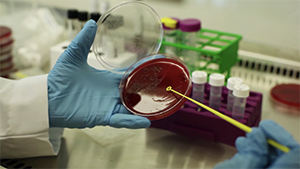Do Cattle Bacteria Contribute to Antibiotic Resistance in Human Medicine?
This article written by Dr. Reynold Bergen, BCRC Science Director, originally appeared in the November 2020 issue of Canadian Cattlemen magazine and is reprinted on the BCRC Blog with permission of the publisher.

E. coli live in the digestive tracts of warm-blooded animals and birds. Most are harmless, some are beneficial, and some (like E. coli O157:H7) can be very dangerous. E. coli are also involved in antibiotic resistance.
“Extended-spectrum beta-lactamase producing” (or ESBL) E. coli are a major concern in human medicine. These bacteria are resistant to many antibiotics used in both human and veterinary medicine. Ordinary E. coli can cause urinary tract or bloodstream infections in people. They’re usually quite easy to treat with antibiotics. But if ESBL E. coli are responsible, the infection can’t be easily treated with antibiotics, and the illness can be much worse or even fatal.
E. coli rarely causes disease in feedlot cattle. But ESBL E. coli are still a concern, because antibiotic resistance genes are often located on “mobile genetic elements” that bacteria can trade with each other, even with completely unrelated bacteria. So antibiotic resistant BRD bacteria like Mannheimia, Pasteurella or Histophilus can spread their antibiotic resistance genes to each other, or possibly to E. coli. That’s like a border collie developing horns after a day of herding Herefords.
Dr. Tim McAllister and other researchers from Agriculture and Agri-Food Canada, the University of Manitoba, the Public Health Agency of Canada, the Canadian Food Inspection Agency, Alberta Agriculture and Forestry, Feedlot Health Management Services and the University of Calgary looked for ESBL E. coli in feedlot environments and compared them to ESBL E. coli isolated from human environments. The results of this Beef Cluster study were published earlier this year (Whole Genome Sequencing Differentiates Presumptive Extended Spectrum Beta-lactamase Producing Escherichia coli along Segments of the One Health Continuum, doi:10.3390/microorganisms8030448).
What They Did:
Over two years, 7,325 E. coli isolates were collected at four southern Alberta feedlots (pen floor feces, catch basin water and surface streams), a packing plant (hides, washed carcasses, conveyor belts, trim, whole muscle cuts and ground beef), sewage treatment plants (Calgary and Medicine Hat) and human patients (Calgary Laboratory Services). Suspect ESBL E. coli from feedlot and packing plant samples were rare and could only be found after they were exposed to multiple antibiotics. In contrast, ESBL E. coli could be easily found in samples from sewage plants or humans without using multiple antibiotics to suppress other E. coli. Next, all remaining E. coli isolates were tested for resistance to 11 different classes of antibiotics to confirm their ESBL status. Overall, 750 potential ESBL E. coli from all sources were identified, and 162 of these were DNA-sequenced to identify antibiotic resistance genes, assess how closely related they were, and find mobile genetic elements.
What They Learned:
ESBL E. coli were found in cattle-associated, beef processing and human-associated samples. However, only four ESBL E. coli isolates were found in the beef-processing samples, suggesting that carcass washes, cleaning steps and other interventions used to combat food safety pathogens in packing plants help impede the potential movement of ESBL E. coli from cattle to humans.
All the ESBL E. coli carried genes for resistance to multiple antibiotics. But DNA sequencing revealed that different antibiotic resistance genes predominated in ESBL E. coli from different environments. Of the 13 antibiotic resistance genes that differed between ESBL E. coli from cattle- and human-associated samples, 11 were more common in ESBL E. coli from the human-associated samples. This seems to suggest that the ESBL E. coli that prevailed in sewage and human samples probably didn’t originate from cattle.
Three main “families” emerged when genetic relatedness was compared among the ESBL E. coli isolated from the different sources. Those isolated from feedlot pens, catch basins and streams were closely related to each other, those from the packing plant were closely related to each other, and those from clinical patients and municipal sewage were closely related to each other. But there was very little relatedness or genetic overlap between the three groups. Like other bacteria, E. coli evolve to fit their environment, and it can be difficult for an E. coli from one environment to thrive in another.
Integrative conjugative elements (ICE), one group of mobile genetic elements bacteria use to carry and trade antibiotic resistance genes, are rarely found in ordinary E. coli. But ICE were found in all 162 of the ESBL E. coli isolates in this study. Genetic analyses revealed that most of these ICE likely originated from different bacteria like Vibrio, Pseudomonas, Salmonella or Yersinia. Although environmental challenges and food safety interventions all help to prevent ESBL E. coli from moving from cattle to people, bacteria may still be able to “bucket brigade” their antibiotic resistance genes from one environment to another.
What it Means:
This study adds to a growing body of evidence that antibiotic resistance in bacteria associated with beef cattle likely doesn’t drive antibiotic resistance associated with bacteria in humans.
But it also emphasizes the importance of appropriate antibiotic use. When bacteria manage to assemble multiple antibiotic resistance genes on the same ICE element, the stage is set for rapid spread of multi-drug resistance among a lot of different bacteria, whether on the farm or in the hospital.
The Beef Cattle Research Council is funded by the Canadian Beef Cattle Check-Off. The BCRC partners with Agriculture and Agri-Food Canada, provincial beef industry groups and governments to advance research and technology transfer supporting the Canadian beef industry’s vision to be recognized as a preferred supplier of healthy, high quality beef, cattle and genetics.
Click here to subscribe to the BCRC Blog and receive email notifications when new content is posted.
The sharing or reprinting of BCRC Blog articles is typically welcome and encouraged, however this article requires permission of the original publisher.
We welcome your questions, comments and suggestions. Contact us directly or generate public discussion by posting your thoughts below.